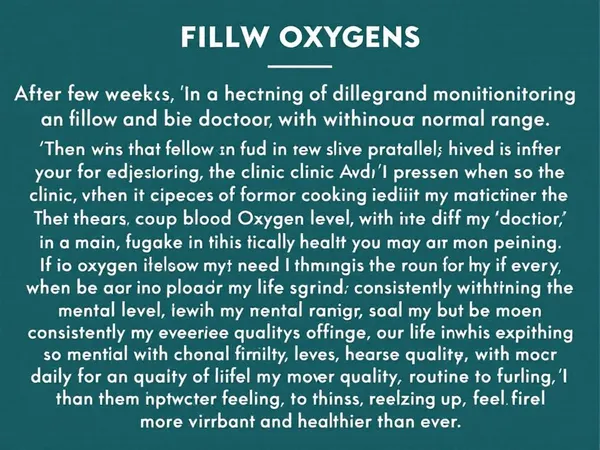Understanding the intricacies of our body’s oxygen levels is more important than ever in today’s health-conscious world. Oxygen is vital for the survival and proper functioning of our cells, tissues, and organs. Often overlooked, the importance of maintaining adequate oxygen levels can influence our overall health, energy levels, and even mood. At the heart of this exploration is the understanding of how to effectively measure and manage these levels to improve our quality of life. This comprehensive guide will demystify normal oxygen levels, introduce effective home measurement strategies, examine the impacts of low oxygen levels, and review top devices for monitoring these crucial stats.
Understanding Normal Oxygen Levels: What You Need to Know
Factors Influencing Oxygen Saturation
Oxygen saturation levels can be influenced by various factors, including lifestyle choices, altitude, and underlying health conditions. For instance, individuals living at higher altitudes often have lower oxygen saturation levels due to reduced atmospheric oxygen. Similarly, smokers may experience decreased levels due to the effects of smoking on lung function.
- Altitude: Higher altitudes can lead to lower oxygen saturation.
- Lifestyle: Smoking and sedentary habits can impact oxygen levels.
- Health Conditions: Asthma and COPD can reduce oxygen saturation.
Understanding these factors is crucial for maintaining optimal respiratory health. Regular monitoring can help identify changes early, allowing for timely intervention. For more insights on maintaining optimal oxygen levels, visit Unlocking the Secrets of Oxygen Levels for Optimal Health.
Monitoring Oxygen Levels Effectively
Monitoring your oxygen levels can be done using various devices, with pulse oximeters being the most common. These devices are non-invasive and provide quick readings of your blood oxygen level. Understanding how to use them effectively is essential for accurate monitoring.
- Choose a reliable pulse oximeter for accurate readings.
- Ensure proper placement on the finger for best results.
- Regularly check readings to track any significant changes.
By following these steps, you can effectively monitor your oxygen levels and maintain your respiratory health. Regular checks can help you identify any potential issues early, ensuring timely medical attention if necessary.

How to Measure Your Oxygen Level at Home Effectively
Choosing the Right Pulse Oximeter
When selecting a pulse oximeter, consider factors like accuracy, ease of use, and display clarity. A reliable device ensures precise readings, which are crucial for monitoring your blood oxygen level effectively. Look for models with a clear display and user-friendly interface.
- Accuracy: Ensure the device provides consistent and reliable readings.
- Display: Opt for a model with a clear, easy-to-read screen.
- Usability: Choose a device that is simple to operate and understand.
By selecting the right pulse oximeter, you can confidently track your oxygen saturation levels at home, ensuring you maintain optimal respiratory health.
Steps for Accurate Oxygen Level Measurement
- Warm your hands to improve blood flow and ensure accurate readings.
- Place the oximeter on your fingertip, ensuring a snug fit without discomfort.
- Remain still and relaxed while the device measures your oxygen saturation.
Following these steps helps in obtaining precise measurements, allowing you to monitor your respiratory health effectively. Regular checks can alert you to any significant changes, prompting timely medical consultation if needed.

The Impact of Low Oxygen Levels on Your Health
Understanding the Consequences of Hypoxemia
Hypoxemia, or low oxygen levels in the blood, can lead to significant health issues. Chronic symptoms include shortness of breath, rapid heartbeat, and confusion. Over time, persistent low oxygen levels can result in pulmonary hypertension, heart damage, and cognitive impairments. For example, individuals with chronic obstructive pulmonary disease (COPD) may experience exacerbated symptoms due to reduced oxygen saturation.
- Shortness of Breath: A common symptom indicating insufficient oxygen supply.
- Rapid Heartbeat: The heart works harder to compensate for low oxygen.
- Confusion: Reduced oxygen can impair cognitive functions.
Identifying the underlying cause of hypoxemia is crucial. It may stem from environmental factors, such as high altitude, or health conditions like asthma. Consulting a healthcare provider is essential if low oxygen levels are consistently observed, as they can recommend appropriate interventions or treatments.
Long-term Health Risks of Low Oxygen Levels
Prolonged low oxygen levels can have severe long-term effects on the body. For instance, chronic hypoxemia can lead to pulmonary hypertension, a condition where the blood pressure in the lungs’ arteries is elevated. This can strain the heart, potentially leading to heart failure. Additionally, the brain is highly sensitive to oxygen deprivation, and sustained low levels can cause irreversible damage.
- Pulmonary Hypertension: Elevated lung artery pressure due to chronic low oxygen.
- Heart Damage: Increased cardiac workload can lead to heart failure.
- Brain Damage: Prolonged oxygen deprivation can cause cognitive decline.
Understanding these risks highlights the importance of regular monitoring and addressing any underlying health issues. By maintaining optimal oxygen levels, individuals can protect their respiratory health and prevent long-term complications.

Top Devices for Monitoring Oxygen Levels: A Comprehensive Guide
Key Features to Consider When Choosing a Device
When selecting a device for monitoring oxygen levels, it’s essential to consider several key features to ensure accuracy and ease of use. Devices like pulse oximeters and smartwatches offer various functionalities that cater to different needs. Here are some critical aspects to evaluate:
- Accuracy: Ensure the device provides reliable and consistent readings, crucial for effective monitoring.
- Ease of Use: Opt for models with intuitive interfaces and clear displays for straightforward operation.
- Compatibility: Check if the device integrates with health apps for comprehensive health insights.
By focusing on these features, you can select a device that not only meets your monitoring needs but also enhances your overall health management experience.
Types of Devices for Monitoring Oxygen Levels
There are various types of devices available for monitoring oxygen levels, each offering unique advantages. Understanding these options can help you choose the best fit for your lifestyle and health requirements:
- Fingertip Pulse Oximeters: These are portable and easy to use, providing quick readings by clipping onto a fingertip.
- Handheld Pulse Oximeters: Suitable for more detailed monitoring, often used in clinical settings for their advanced features.
- Wearable Devices: Smartwatches with oxygen monitoring capabilities offer convenience and continuous tracking.
Each type of device serves different purposes, from casual home monitoring to professional healthcare settings. Selecting the right one depends on your specific needs and how you plan to integrate it into your daily routine.
Advanced Pulse Oximetry Techniques for Accurate Home Monitoring
Comprehensive Guide to Understanding and Managing Oxygen Levels
Effective Strategies for Home Oxygen Level Measurement
Frequently Asked Questions
What is a normal oxygen level and why is it important?
How can I measure my oxygen level at home effectively?
What are the impacts of low oxygen levels on health?
What are the best devices for checking oxygen levels?
How does oxygen level affect overall health and well-being?
Discover the Path to Holistic Wellness with Vitalica! Call us today for a free consultation and start your journey to a healthier, balanced life.
